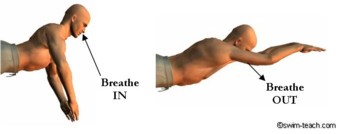1) Body Position
The body position for breaststroke should be inclined slightly downwards from the head to the feet.
The body should be as flat and streamlined as possible with an inclination from the head to the feet so that the leg kick recovery takes place under the water.
Head movement should be kept to a minimum and the shoulders should remain level throughout the stroke.
The main aim should be good streamlining, however the underwater recovery movements of the arms and legs together with the lifting of the head to breathe, all compromise the overall body position. In order to reduce resistance created by these movements, as the propulsive phase of an arm pull or leg kick takes place, the opposite end of the body remains still and streamlined.

2) Leg Kick Technique
During breaststroke it is important for a swimmer or swimming teacher to recognise the difference between the wedge kick and the whip kick. The leg action provides the largest amount of propulsion in the stroke and swimmers will favour a wedge kick or a whip kick depending on which comes most naturally.

For a whip kick, the legs kick in a whip-like action with the knees remaining close together. For a wedge kick the legs kick in a wider, more deliberate circular path.
The leg kick as a whole should be a simultaneous and flowing action, providing the majority of the propulsion. Knees bend as the heels are drawn up towards the seat and toes are turned out ready for the heels and soles of the feet to drive the water backwards. The legs sweep outwards and downwards in a flowing circular path, accelerating as they kick and return together and straight, providing a streamlined position.

3) Arm Technique
The amount of propulsion generated from breaststroke arm techniques has developed over the years as the stroke has changed to become more competitive.
The arm action overall provides the smallest propulsive phase of the four competitive strokes.

Catch
Arm action begins with the arms fully extended out in front, fingers and hands together. Hands pitch outwards and downwards to an angle of about 45 degrees at the start of the catch phase. Arms pull outwards and downwards until they are approximately shoulder width apart. Elbows begin to bend and shoulders roll inwards at the end of the catch phase.
Propulsive phase
Arms sweep downwards and inwards and the hands pull to their deepest point. Elbows bend to 90 degrees and remain high. At the end of the down sweep, the hands sweep inwards and slightly upwards. Elbows tuck into the sides as the hands are pulled inwards towards the chest and the chin.
Recovery
Hands recover by stretching forwards in a streamlined position. Hands recover under, on or over the water surface, depending on the style of stroke to be taught.
4) Breathing Technique
Breaststroke action gives a natural body lift which gives the ideal breathing point with each stroke.
Inhalation takes place at the end of the insweep as the body allows the head to lift clear of the water. The head should be lifted enough for the mouth to clear the surface and inhale, but not excessively so as to keep the frontal resistance created by this movement to a minimum.

Explosive or trickle breathing can be utilised.
Head returns to the water to exhale as the arms stretch forward to begin their recovery phase.
Some swimmers perform the stroke with the head raised throughout to keep the mouth and nose clear of the water at all times. This simplifies the breathing.
5) Timing & Coordination
The coordination of breaststroke propulsive phases should be a continuous alternating action, where one propulsive phase takes over as one ends.
Breast stroke timing and coordination can be summed up with the following sequence: pull, breathe, kick, glide.

A streamlined body position at the end of the timing sequence is essential to capitalise on the propulsive phases of the stroke. The timing can be considered in another way: when the arms are pulling in their propulsive phase, the legs are streamlined and when the legs are kicking in propulsion, the arms are streamlined.
Full body extension is essential before the start of each stroke cycle.

Competitive variations in stroke timing can be found by decreasing or even eliminating the glide and using the arm and leg actions in an almost continuous stroke to give more propulsion.
Head returns to the water to exhale as the arms stretch forward to begin their recovery phase.
Some swimmers perform the stroke with the head raised throughout to keep the mouth and nose clear of the water at all times. This simplifies the breathing.
5) Timing & Coordination
The coordination of breaststroke propulsive phases should be a continuous alternating action, where one propulsive phase takes over as one ends.
Breast stroke timing and coordination can be summed up with the following sequence: pull, breathe, kick, glide.

A streamlined body position at the end of the timing sequence is essential to capitalise on the propulsive phases of the stroke. The timing can be considered in another way: when the arms are pulling in their propulsive phase, the legs are streamlined and when the legs are kicking in propulsion, the arms are streamlined.
Full body extension is essential before the start of each stroke cycle.

Competitive variations in stroke timing can be found by decreasing or even eliminating the glide and using the arm and leg actions in an almost continuous stroke to give more propulsion.
No comments:
Post a Comment